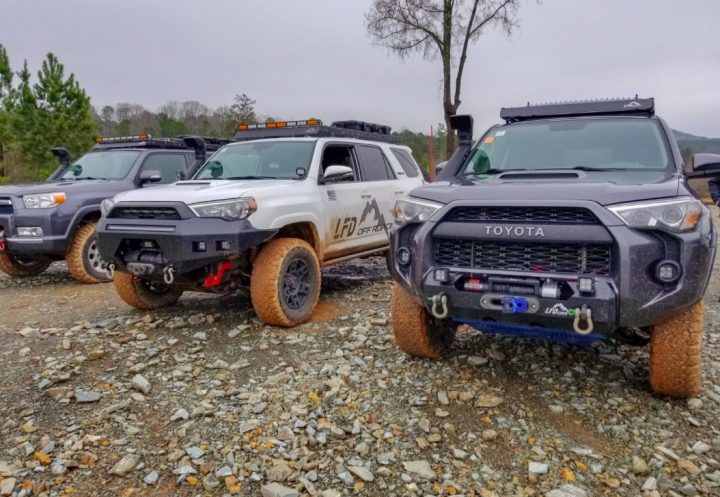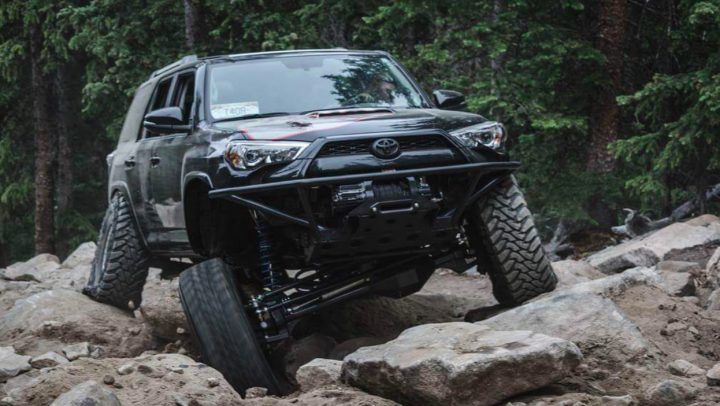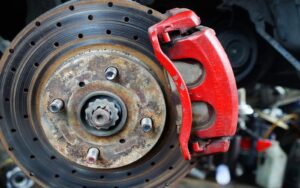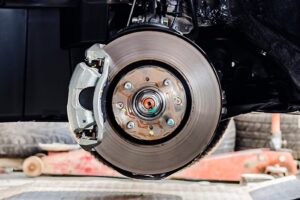What is the Crawl Control system? Developed by Toyota, Crawl Control controls your truck or SUV in low-speed off-road conditions where traction is minimal. Similar to all-wheel drive crawl control goes further where it automatically controls each wheel with throttle and brake to give you create the most control. It will minimize your tires digging deep in sand and water.
It is sort of a dumb autopilot where you can focus only on steering. The traction and acceleration parts are completely automated until you deactivate them by pressing on the brakes. Crawl Control has been around for a while. It is a feature pretty much only offered on TRD or Limited Toyota trim packages.
Table of Contents
What Year Did Crawl Control Come Out?
Crawl Control was developed and debuted in 2008. 5th generation 4Runners were equipped with Crawl Control starting in 2009.
How Does Toyota Crawl Control Work?
Crawl Control is very similar to all-wheel drive and cruise control. It takes power from wheels that don’t have traction and send the power to other wheels. Crawl Control does this automatically while maintaining a constant speed. It uses numerous sensors to monitor traction, speed, and braking.
So you are essentially riding through the sand or mud with your feet on the dash steering through the many surprises that come along. Your truck’s Crawl Control will maintain a constant speed and traction (if possible) through demanding terrain. This way you can concentrate solely on steering and maneuvering instead of trying to keep the wheels from spinning constantly.
Crawl Control maintains a steady low speed It’s meant to be driven at a slow, constant, and safe speed. It provides a boost of power when the truck needs it most. You can adjust the terrain you are driving on by adjusting the settings of your dial on your dash just as you would for normal driving conditions.
In addition, Crawl Control uses the ABS, and other braking system capabilities to slow down when needed. As well as reduce speed when it senses that you are about to take an incline or decline.
Crawl Control enables you to apply the brakes without affecting your speed. This allows for better control of the truck while maneuvering tough terrains such as steep hills or the edge of a ravine.
Crawl Control can be utilized in extremely difficult terrain conditions by making it possible to maintain constant speeds when traversing rough ground. This helps when you’re stuck at the bottom of steep inclines and declines when climbing uphill, traversing through water or mud, or even crossing railroad tracks.
The Technology Behind Crawl Control
Crawl Control monitors wheel speeds, throttle position sensor, brake sensors for each wheel, engine RPMs to determine if the wheels are spinning. If the wheels are not accelerating or decelerating then Crawl Control will activate. The truck has five different settings that you can choose from depending on what type of terrain you are driving.
These settings are Sand, Mud, Rock, Auto and Custom. The last option allows you to manually adjust the speed at which it will activate. The other four options basically set Crawl Control to automatically activate depending on what type of terrain you’re driving in or setting it to a specific speed that is recommended for each type of terrain.
In sand or mud, it’s best to have minimum tire spin to prevent the truck from slipping and losing control. It may be a good idea to keep your speed at a reasonable rate until you find solid ground again regardless if Crawl Control is activated or not. If Crawl Control senses that undercarriage damage is about to occur, the system will disengage temporarily.
As for rock crawling, you can have full control of your throttle at all times because it won’t affect the torque being sent to the wheels. This setting also controls how much power will be transmitted according to what mode you choose “1” for low range or “2” for high range.
Auto is designed for just that, automatically shifting the gears into low range if necessary to maintain steady speeds. There can be times when Crawl Control may not be able to detect solid ground and will disengage temporarily depending on your speed and throttle position. As you become familiar with what terrain you are driving in, there shouldn’t be a problem.
Hills are easier to navigate through when using Crawl Control in Auto or Rock mode because you won’t have to maintain any special speed. If your wheel slips, the system will automatically adjust accordingly so there is no need to keep your foot on the throttle wondering if it’s too much power being sent to the wheels for the terrain.
This is where custom comes in handy. It allows you to adjust the speed and gear on your own which can help with the overall control of the vehicle on certain types of terrain. This may also be beneficial when your wheels are spinning too much and you don’t want Crawl Control to activate at all or allow it enough time to activate before you take the hill.
Does The 4Runner Have Crawl Control?
The fifth-generation 4Runner (2009-current) was the first to offer Craw Control. It started is available in the “Trail Edition” (now part of the TRD line) with some other off-roading features that let you drive off-road in luxury:
“The new Trail Edition offers Toyota’s Kinetic Dynamic Suspension System (KDSS) and Crawl Control which had previously only been available to premium Toyota vehicles, as well as a rear locking differential like the previous Trail Package.” – Wikipedia
Toyota has had over a decade of experience tweaking its Crawl Control feature to get it just right. It is not perfect but Toyota keeps improving since it was released in 2009.
The TRD line makes up only about 4% of the 4Runner’s total annual sales, so it would be rare to hop in a 4Runner with Crawl Control. Out on the trails, it may be less uncommon overall.
Does SR5 Have Crawl Control?
No, the Toyota 4Runner SR5 trim does not have crawl control. Only the TRD package has Crawl Control, which is a step above the more basic SR5 package. The TRD trim is basically the SR5 package and Toyota adds off-road focused features to the existing platform such as:
- Dynamic suspension
- Electronic locking differential
- Level type transfer case
- Running boards
Crawl Control is not available on any 2WD trucks.
What Does TRAC Do On A 4Runner?
Active Traction Control or A TRAC is a feature used when off-roading. It transfers torque to wheels that have the most grip on the ground by actively braking each wheel that does not have any traction with the ground.
It optimizes power sent to wheels so the driver can have the most control over the SUV. It is ideal when in snow or mud-type conditions. Some like to call it a “brake locking differential” which is sort of accurate. It is an active process that acts in the same way a locking diff does.
All 4Runners have A TRAC. It should not come as a surprise either. It is a simple system that has been in 4Runners for ages. It adds an immense amount of control to the vehicle, almost as much so as going from 2WD to 4WD.
The Toyota 4Runner has been an offroading staple since the early 1980s. It is almost as common as a Jeep in the hills. With this type of history, the amount of attention and experience off-roading would be hard to beat.
Toyota proves that with its features if offers in the 4Runner. From A TRAC to Crawl Control to other luxury 4×4 features, there isn’t a shortage of comfort.
The technology behind these features is not too complex, though few other automakers have it. If you wonder how does crawl control works it is not too different than locking differentials or all-wheel drive.
Why Use Atrac Over Crawl Control
ATRAC makes certain all four wheels are driving at a crawl speed by reducing engine output. Crawl Control modulates the throttle to keep the vehicle moving at a crawl, but ATRAC does it automatically so your foot can stay on the brake pedal.
Once you take your foot off the brake, ATRAC downshifts to second gear. You can use either system at any speed or pitch, but if you are stopped on an incline, Crawl Control may get you moving again sooner than ATRAC because it’s keeping the throttle open.
A lot of people don’t prefer driving with a foot firmly planted on the brake pedal. ATRAC is an option for those who don’t like driving with their right foot to the floorboard.
Benefits Of Using Atrac Instead Of Crawl Control
The benefits of ATRAC over Crawl Control are:
- ATRAC will not get you moving if you’re stuck on a hill.
- (Crawl Control can) ATRAC is automatically engaged when the transfer case switch is in 4Low and needs no input from the driver. (Crawl Control must be turned on by hitting a button.)
- As long as your vehicle has an automatic transmission, it has ATRAC whether or not your vehicle is equipped with Crawl Control.
- If you don’t want to use the brake pedal, ATRAC lets you keep both feet on the floor.
Drawbacks to using ATRAC instead of Crawl Control
Crawl Control is better than ATRAC for:
- Crawl Control can be used on a hill to get you moving.
- ATRAC cannot be used with the transfer case switch in 4High or 4Low.
- The downshifting of ATRAC won’t help your gas mileage, but Crawl Control does not upshift so it preserves fuel economy better than ATRAC, which aggressively downshifts.
The idea of Crawl Control is to maintain a crawl speed and it does that by modulating the throttle. ATRAC will drop you into second gear and preserve momentum, but if you’re crawling along on an incline or descending an off-ramp at 5 MPH in 4Low, ATRAC won’t help you – your vehicle may just sit there.
This is where Crawl Control would modulate the throttle to keep the wheels turning and move your vehicle at a crawl.
Your truck has ATRAC whether or not it’s equipped with Crawl Control. If you want an automatic 4WD system that can be used on hills, get one with Crawl Control.
You know, I’m surprised Toyota has not come up with a system that keeps you from rolling down the hill in Auto-4WD mode and engages 4Low if it detects wheel spin. Wouldn’t it be nice to use Auto-4WD on flat or level roads, but still have full-time 4Low available when needed?
When To Use ATRAC Or Crawl Control
Toyota proves that with its features if offers in the 4Runner. From A TRAC to Crawl Control to other luxury 4×4 features, there isn’t a shortage of comfort.
The technology behind these features is not too complex, though few other automakers have it. If you wonder how does crawl control works it is not too different than locking differentials or all-wheel drive.
To understand the basics of this technology you should know that a differential is a gearbox filled with a special fluid. It sends power to the wheels while allowing them to rotate at different speeds, thus avoiding wheel slip and keeping your vehicle going in a straight line.
A constant velocity or open differential constantly sends power to both drive shafts while allowing them to rotate at different speeds. This type of system is great for getting maximum traction in winter or slippery conditions, but it limits how much power can be applied depending on the traction available at each wheel.
When your vehicle tries to turn, the outer wheels produce more torque than the inner ones do. Because this difference in torque causes the outer wheels to turn faster than the inner wheels, your truck may slide or even slip sideways (known as oversteer).
Crawl Control and ATRAC help by sending different amounts of torque to each wheel. This technology can help you maintain control in difficult terrain and on steep hills or it can be used for better fuel economy.
Main Takeaways – ATRAC Vs Crawl Control
The main difference between the two is that ATRAC will give you a more natural speed, whereas crawl control can be used to slow down or speed up playback.
Both methods have their pros and cons depending on what you want- so it’s really just about figuring out which one suits your needs best! But if we had to recommend one over the other, we would say go with ATRAC because it gives you true human speech at its most accurate pace.
Crawl Control allows you to set your desired speed for crawling and it’ll automatically adjust the number of pages crawled per day. This is great if you don’t want to worry about how many pages are being scanned each day or if you’re looking for a quick way to get an overview of what’s happening with your site.
It does not, however, offer any insight into which specific URLs were crawled during that time period, so keep in mind that this option may be best suited for those who just need general information.
For example, managers might find it useful because they don’t have access to Google Analytics data but still need some form of website analytics without having the technical know-how required by other options.
Thanks for reading and stay dirty






![The 16 Most Aggressive All Terrain Tires [2022] reall aggressive all terrain tires on a Jeep](https://149868043.v2.pressablecdn.com/wp-content/uploads/2020/03/slide1-e1585156691843-300x150.jpg)

